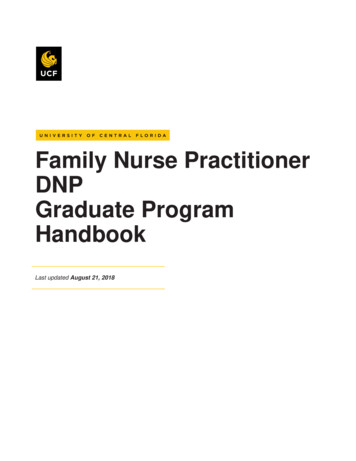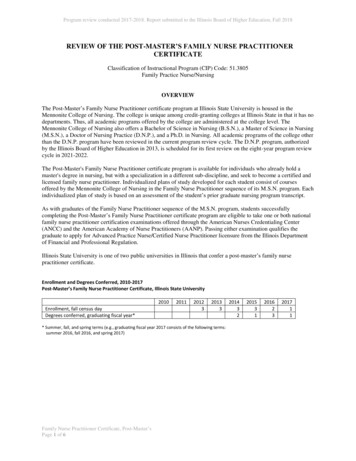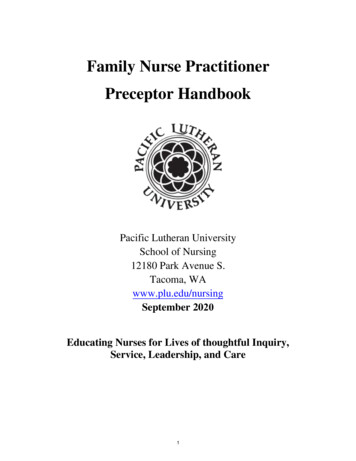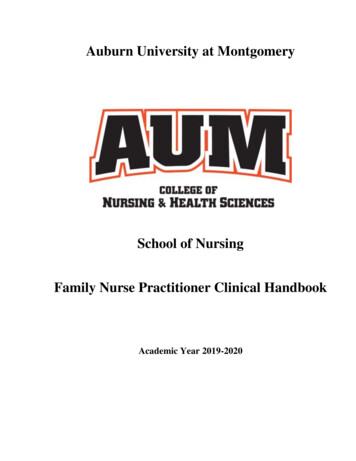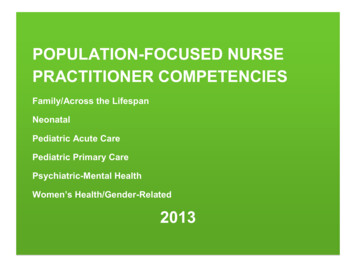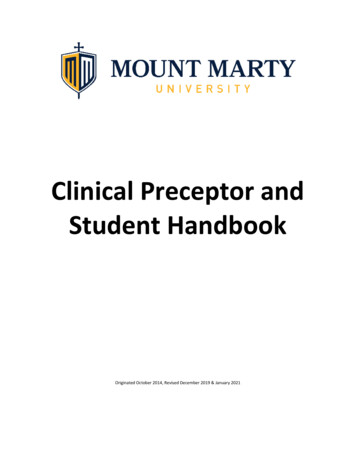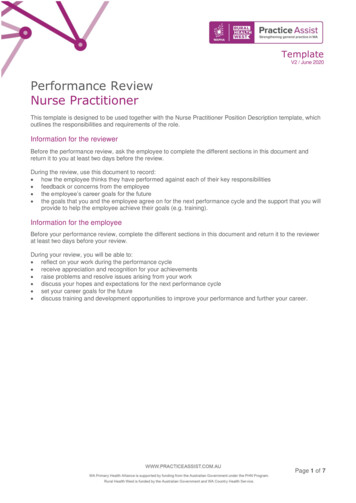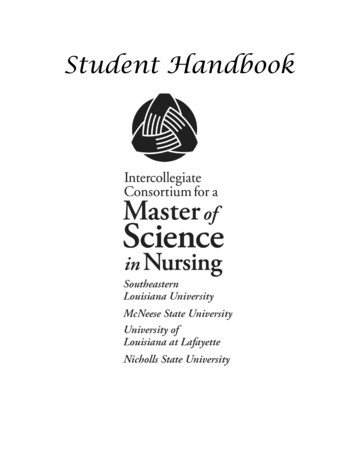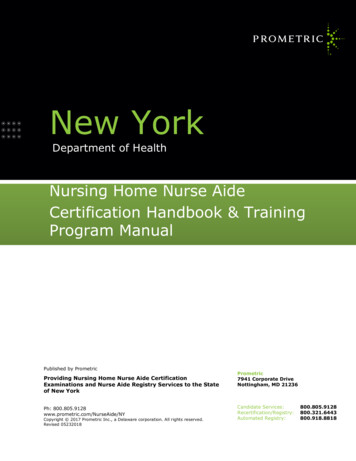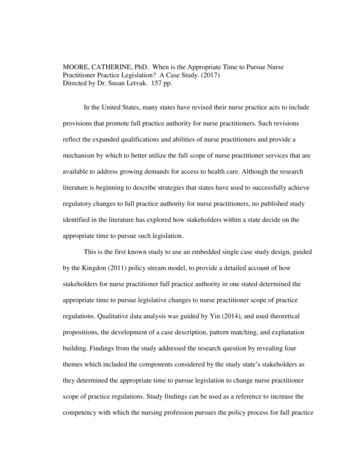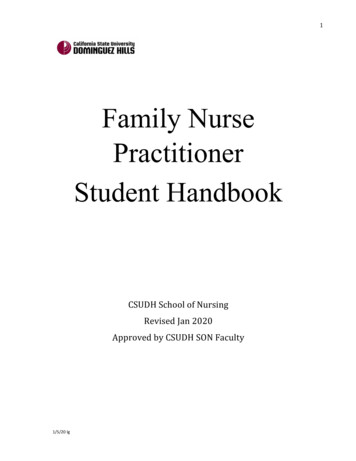
Transcription
1Family NursePractitionerStudent HandbookCSUDH School of NursingRevised Jan 2020Approved by CSUDH SON Faculty1/5/20 lg
2Table of ContentsPART I: Background . 3Introduction and Welcome to the FNP Program . 3FNP Handbook. 4Accreditation . 4Overview of the Family Nurse Practitioner Program . 5Clinical Sites and Preceptors . 5Certification as a Nurse Practitioner by the Board of Registered Nursing . 6National Certification . 6MSN Pathway Students . 6Credit for Prior Primary Care Experience . 6The Family Nurse Practitioner Curriculum . 7The Clinical Experience: Clinical Requirements and Preparation . 7FNP Program Clinical Experience Requirements . 7Clinical Preceptors, Sites & Placements . 8The Faculty Role . 8The Student Role . 9The Clinical Instructor’s Role . 10The Preceptor Role . 11The Site Evaluator Role . 11Academic Policies . 12Progression Policies . 12Program Progression with Standardized Examinations . 13Withdrawal Policies . 14Clinical Policies . 14Behavioral Policies – expected professional conduct. 15Confidentiality. 15Ethical Behavior and Academic Integrity . 15Professional Behavior . 15Impaired Behavior . 16Dismissal Policy . 16Clinical Requirements, Learning Contract, and Preceptor Information . 17PART II: Preparation for Clinical Experiences . 18CLINICAL PROGRESSION PACKET . 18Due Dates & Deadlines FNP Role Progression Packet & clinical requirements: . 19Due Dates & Deadlines Learning Contract: . 20Clinical Site Affiliation Contracts . 20Clinical Activities . 20Appendices . 22Appendix A – School of Nursing Mission, Philosophy & Objectives . 22Appendix B – FNP Statement of Purpose, Philosophy, & Objectives . 24FNP Clinical Course Descriptions, Course Objectives, & Student Learning Outcomes . 251/5/20 lg
3Appendix C – 2019 FNP Plans of Study. 27Appendix D – FNP Program Clinical Placement Form . 30Appendix E – Castlebranch & Clinical Requirements Instructions . 31CSUDH Clinical Document Requirements to be uploaded to Castlebranch . 32Medical Document Manager . 32Castlebranch Clinical Forms & Document Managers to order . 33Appendix F – School of Nursing Full-Time Faculty and Contact Information . 37Appendix G – Electronic Log System for FNP Courses. 38Appendix H – Evaluation of Preceptor & Clinical Sites Forms . 39PART I: BackgroundIntroduction and Welcome to the FNP ProgramWelcome to the Family Nurse Practitioner (FNP) program in the School ofNursing (SON) at California State University, Dominguez Hills (CSUDH). TheFNP program began in 2001 and to date, has graduated 416 family nursepractitioners who are providing primary health care to their patients incommunities all over California. Our program is primarily on-line, designed forthe working nurse who may not be able to attend a traditional program due togeography, time, or life limitations. Our program is for students who arelicensed as Registered Nurses in California and all clinical experiences will bein California settings.The FNP program will prepare you to provide primary care to patients of all ages in anambulatory setting such as a clinic or private physician’s office. Your responsibilities willbe to gather a history, conduct a physical examination; analyze diagnostic test results,consult with colleagues, make a diagnosis, order additional diagnostic tests if needed,select appropriate non-pharmacologic, and pharmacologic treatments according to thediagnosis, and provide education as appropriate while taking into considerations theunique perspectives and characteristics of each individual patient. If necessary, you willrefer the patient to other health care professionals when needed and consult appropriatelywhile insuring your plans of care are the latest and best for your patient.As an FNP student, you will have a nurse practitioner or physician preceptor andcomplete clinical hours in primary care, outpatient settings. To take on this role you needto be an experienced registered nurse, have outstanding oral and written communicationskills, and be an independent thinker with excellent critical thinking and decision-makingskills. You will have excellent knowledge of pathophysiology, physical assessment, andpharmacology. Your practice will be evidenced and theory based, and you will utilizecurrent research from all disciplines to make the decisions that will be in the best interestof your patients. You will practice ethically and with your patient’s safety and health and1/5/20 lg
4well being always at mind. You will communicate clearly with the patient and besensitive to your patient’s needs and cultural perspectives and beliefs.Graduates of our program qualify for California Board of Registered Nursing (BRN)certification as a nurse practitioner, and a furnishing number by applying to the CaliforniaBRN. Graduates also qualify to sit for a national certification examination as a FamilyNurse Practitioner through the American Nurses Credentialing Center and the AmericanAssociation of Nurse Practitioners. Although not currently required by the Calif. BRN,national certification is required by many employers and insurance companies, includingMedi-Cal/Medicare.FNP HandbookThe FNP Handbook serves as a guide to the FNP program at CSUDH. Itincludes the policies specific to the FNP program and it provides an orientationto the roles and responsibilities of the student, instructor and preceptor in theSchool of Nursing courses. Whether you are an instructor, or student, pleaseread the FNP Handbook carefully to understand the roles of each and theinteractions among all that are required for successful learning in completion oftheory and clinical courses. It is expected that students will provide thepreceptor with a copy to review the sections pertinent to preceptors.All FNP students are responsible for knowing and following the guidelines,policies and procedures in this handbook and those posted on the CSUDH website for SON and CSUDH graduate students). The FNP Handbook is updatedand published each summer as needed. FNP students have access to the FNPadvising site where information is posted and frequently updated under the“organizations” tab in Blackboard. Students are strongly encouraged to accessthe advising site and review the FNP Handbook on a regular basis. It also isadvised that each student review the University catalog for the year ofadmission for specific University policiesAccreditationThe FNP program, as part of the Master of Science in Nursing Program atCSUDH, is accredited by the Commission on Collegiate Nursing Education(CCNE). The University is accredited by the WASC Senior College andUniversity Commission (WSCUC).The FNP program meets the requirements of the California Board of RegisteredNursing (BRN) and is a BRN-approved nurse practitioner program. RegisteredNurse Graduates of this program are eligible to be certified as nursepractitioners in the State of California. Students who successfully complete thisprogram are qualified to take national certification examinations as FamilyNurse Practitioners.1/5/20 lg
5Overview of the Family Nurse Practitioner ProgramThe CSUDH School of Nursing offers the Family Nurse Practitioner Programfor nurses who want to develop advanced practice knowledge, skills andcompetencies in primary care of the family. There is a focus on wellness, healthpromotion and maintenance, disease prevention, disease treatment, andrehabilitation. Included in the course of study are advanced health assessment,advance pharmacology and advanced pathophysiology. In addition,comprehensive assessment and management of common acute, chronic andcomplex health problems across the life span within a culturally diverseenvironment comprise the curricular path.Didactic content is taught on line and students are required to have adequatecomputer equipment, internet service, and computer skills with various softwareprograms to complete the course assignments. On-campus testing andinstruction sessions are mandatory for Advanced Health Assessment and allFNP role option courses. The frequencies of mandatory on-campus sessionsvary from semester to semester and are designed to meet course objectives andBRN requirements. The frequencies of these sessions for clinical coursestypically occur between one and three times per semester, at the discretion ofthe faculty.Coursework needs to be completed according to established Plans of Study(appendix C) that include: MSN APRN core courses (3P’s), FNP role (didactic)and role performance (clinical) courses and the culminating experience for atotal of 48 units. Deviations from the student’s selected Plan of Study are notallowed without approval of the FNP Program Director. Achievement ofprogression milestones, such as the Graduation Writing AssessmentRequirement (GWAR) and passing standardized, nationally normed exams,developed for Family Nurse Practitioner students, is required for progression inthe program.The FNP program is rigorous and students will need to adjust work and life schedules toaccommodate on-line course work, readings, on-campus instruction days, and clinicalpractice days in ambulatory settings that usually are open Monday to Friday, duringnormal working hours. Part-time students should expect to invest approximately 26-30hours per week and full-time students should plan for 36-44 hours per week. Summercourses are subject to availability and may not always be available. Prior to beginning thefirst clinical practicum, health requirements must be satisfactorily completed.Clinical Sites and PreceptorsProgram representatives assign students to the clinical sites and preceptors. The programwill consider recommendations and requests for preceptors from students. Students are tosubmit a completed Clinical Placement Form early each semester (see due dates and1/5/20 lg
6deadlines in Table of Contents) for assignments the following semester. All clinical sitesand preceptors must be approved by the program instructors and fit the requirements foreach course. An affiliation agreement (signed contract with the clinical agency) must bein place prior to starting clinical hours.Certification as a Nurse Practitioner by the Board of Registered NursingAfter the degree is awarded, the successful student can apply to the CaliforniaBoard of Registered Nursing (BRN) for a certificate to practice as a nursepractitioner. The Pharmacology course (MSN 526), meets the BRN criteria foran approved pharmacology course to support an application for a furnishingnumber. Application to the BRN to practice as an FNP and to furnishmedications occurs only after the successful completion of the program; awardof the MSN/ FNP degree; and submission of both applications with fees to theBRN. This process can take several months after the completion of the program.National CertificationNational certification as an FNP is not currently required in the State ofCalifornia, however, many employers do require this and reimbursement toyour employer for your professional services by the patient’s MediCal andMedicare coverage requires that you have national certification as an FNP. It ishighly recommended that students apply to one of the national certificationexamination organizations during their final semester. Research has shown thatstudents perform best on these examinations when taken soon after graduation.National certification for FNPs is available from the American Academy ofNurse Practitioners or the American Nurses Credentialing Center.MSN Pathway StudentsThe MSN pathway program is for registered nurses with non-nursing baccalaureatedegrees. Pathway students must participate in an MSN Pathway workshop during whichthe pathway advisor will determine the BSN courses required for the MSN program.Pathway students apply for admission to the FNP program after all undergraduate prerequisite courses are completed (Pathophysiology, Health Assessment with Lab, andResearch). The Pathway Coordinator creates an individualized plan for each student. Allrequired BSN “bridge” courses must be completed prior to starting the sequence ofgraduate courses as outlined in the FNP Handbook.Credit for Prior Primary Care ExperienceStudents with previous primary care education or experience as a primary care providerare allowed to challenge content within courses specific to their area of expertise. Forexample, certified Women’s Health Nurse Practitioners may request to challenge contentrelated to their knowledge and experience in providing care related to women’shealth. Students who wish to discuss credit or challenge options should contact theDirector of the FNP Program to review prior transcripts and clinical experiences,according to their individual situation.1/5/20 lg
7The Family Nurse Practitioner CurriculumThe FNP curriculum is composed of MSN core, APRN core, and role-specific FNPcourses that total 48 semester units. See course descriptions in CSUDH ndex). Students select a 3 or 4 year Plan ofStudy (appendix C).The FNP program includes didactic (theory) courses and practice-based, clinical, “roleperformance” courses. Each course is comprised of specific student learning outcomes(i.e. learning objectives), activities, and evaluation measures. The didactic coursespresent the nursing knowledge, theoretical concepts, models, and research that informpatient care and evidence-based practice. The clinical courses provide opportunities forstudents to apply knowledge; practice skills; plan, implement and evaluate interventionsand programs; and learn the full scope of the FNP role for which they are preparing.The curriculum is delivered primarily in web-based courses taught online through theInternet, or in hybrid format (web-enhanced with some on-campus sessions). Web-basedcourses are available to students through the Blackboard Learning Management System.MSN 521/522 Advanced Health Assessment and the FNP clinical role performancecourses are web enhanced; each course requires between one and three on-campussessions. On campus attendance is mandatory, the exact number of sessions/hours varyaccording to the course.The Clinical Experience: Clinical Requirements and PreparationFNP Program Clinical Experience RequirementsIn accordance with the State of California Board of Registered Nursing CSUDH FNPstudents complete a total of 576 precepted clinical hours. This is met by completing 144clinical precepted hours each semester in primary care in each of four clinical roleperformance courses. Students must promptly enter, and frequently review, theircumulative Patient Encounter Log records (Elogs) to ensure that these requirements have,or will be met prior to intended graduation. At the beginning and end of each semester,the clinical instructor will go over the hours completed and the hours needed in each ofthe areas listed below. Each role performance course has specific Student LearningOutcomes (objectives) that must be met in order to progress in the program. FNP roleperformance courses must be completed in the state of California. Clinical hours must beperformed during regular semester hours. Students may not attend clinical duringholidays, winter and spring break, summer or University closure dates.Minimal specialized clinical expectations for the total program are: 100 hours with pediatric patients 100 hours with geriatric patients over the age of 66 60 hours of women’s health 40 hours with obstetrics patients 20-40 pelvic examinations1/5/20 lg
8All clinical experiences will address a variety of topics including health promotion,acute/chronic psychosocial issues, and physical health problems that are typically seen ina primary care setting. The focus of the first semester is primary care for general healthproblems. The focus of the second semester is women & gender health, obstetrics, andpediatrics. The focus of the third and fourth semesters is primary care for acute andcomplex chronic health problems that may be found in internal medicine settings.Specialized clinical experiences are allowed for short periods during the last semester asapproved by the instructor. Some examples of these include: diabetes, orthopedics,dermatology (not medi-spa), AIDS clinics, etc.; they may not be a major focus in thestudent’s clinical experiences unless the student is performing common primary carefunctions in those specialty sites. Limited experiences in emergency rooms and urgentcare are allowed with approval in the third and fourth semesters. The clinical instructor orFNP Director approves the specialty sites on a case-by-case basis. Clinical experiences inacute care (in-patient hospital), and skilled nursing facilities are not permitted.Clinical Preceptors, Sites & PlacementsThe ideal Preceptor is a Family Nurse Practitioner with a minimum of a Master ofScience in Nursing degree and experience in the role. Other acceptable preceptors includenurse practitioners other than FNP, nurse midwives holding a Master’s Degree for theobstetric hours, and physicians, (Medical Doctors (MD) or Doctor of Osteopathy (DO).Physician Assistants are not approved as preceptors for FNP students.FNP program representatives will assign clinical sites and Preceptors with the goal ofmatching the student’s geographic location and experience to the site. Students will beplaced at sites within 100 miles of the student’s home based on information obtainedfrom the Clinical Placement Form.A student may request a specific preceptor. If an appropriate provider has been identifiedwho agrees to be a preceptor, the student makes this request on the Clinical PlacementForm. The FNP Director (or designee) must approve all preceptor requests. If approved,the student requests an Affiliation Agreement with the clinical site (see School ofNursing Website). Students are expected to stay in contact with the clinical placementrepresentative throughout the summer. Make sure to check CSUDH email frequently.First semester students will not be approved to complete clinical hours in urgent caresites, specialty sites, including urgent care may be requested during the final semesters.The Faculty RoleThe members of the CSUDH School of Nursing faculty have doctoral and/or master’sdegrees related to their field of nursing practice. They serve as master educators andprofessional mentors for students and colleagues, as well as facilitators, instructors, rolemodels and resource persons in their particular area of expertise.1/5/20 lg
9As an instructor, the faculty guides and facilitates the learning process and evaluates thestudents according to the course objectives and the students’ performance of the learningactivities for a particular role outcome. Clinical instructors and site evaluators assesslearning opportunities and evaluate the student’s performance in the clinical setting.The SON Director, the MSN Program Coordinator and FNP Program Director are thefaculty who administer the School of Nursing, FNP Program. They are responsible forscheduling courses and overseeing the contractual arrangements with the affiliatedclinical sites. Together with the course faculty, they implement and interpret policies andprocedures pertaining to the clinical learning component of the programs.The Student RoleCSUDH School of Nursing students are adult learners and the curriculum is designed forthe adult learner. The faculty expects students to be self-directed and internallymotivated. The faculty recognizes that as adult learners mature, they become morediverse and vary widely in learning styles, motivation, prior experience and patterns ofparticipation in educational programs. Therefore, our programs use the learning strategiesthat meet the adult learner’s need to participate in defining needs, goals, activities, andevaluation of outcomes.Faculty incorporate and build upon the assumptions that the adult learner: Is self-directed.Has accumulated experiences that serve as a resource for learning.Has a need to relate learning to real-life situations.Wants to apply newly acquired knowledge and skills immediately.Professional nurses lead very full lives and because of that, may have difficulty makingtheir educational studies a priority at all times. To be successful, students must be wellorganized and make plans to adjust their lives to fit the demands of this rigorous program.Student responsibilities during the clinical preceptorship:1. Complete the learning contract for each clinical course, write objectives based oncourse objectives and opportunities available in the assigned clinical setting.Consult with course faculty and preceptor as appropriate. (Appendix D)2. Practice within the framework and policies of the FNP Program, SON, CSUDH,and the assigned agency.3. Seek direct and indirect supervision from the instructor as needed.4. Participate in conferences with the instructor and preceptor; seek feedback aboutprogress toward completing the learning contract.5. Maintain the Elogs during or after each clinical session. Complete other requireddocumentation as assigned by instructor or preceptor (activity log, clinicaljournal, patient database, etc.). (Appendix F)6. Act in an ethical and professional manner at all times, arriving on time and fullyprepared for each clinical session; inform the agency and instructor if unable to1/5/20 lg
10arrive at the agency as scheduled. Wear professional dress with a lab coat andstudent ID tag at all times while in the clinic.7. Fulfill the learning objectives, assignments, and submit by due dates as stated inthe syllabus for each clinical course.8. Participate in group and individual conferences as scheduled by the instructor.9. Evaluate the course, instructor, clinical experience and clinical agency on thestandard evaluation forms at the end of each semester.10. Students are encouraged to improve their learning experience by using thefollowing strategies: Developing supportive relationships Finding others with different learning styles to form a study groupImproving the fit between their learning style and their lifestyle orsituation Becoming a more adaptable and flexible learner Strengthening their areas of weakness Developing a long term plan and setting short term goals Seeking safe opportunities to practice new skills Rewarding themselves each step along the wayThe Clinical Instructor’s RoleThe role of the clinical instructor is an important component of the clinical educationexperience. The instructor teaches the clinical course, assists in arranging for clinicalexperiences and oversees the student’s performance and clinical experience. Theinstructor works with the student to structure the learning experience and develop thelearning contract, monitors and assesses appropriate learning experiences to facilitate thestudent’s achievement of the course objectives. The instructor is also responsible andaccountable for assuring that it is possible to meet the course objectives in a specificagency. The instructor communicates on a regular basis with the student regardingstudent progress and learning needs, and is available to resolve problems if they arise.The course instructor is responsible for evaluating the student’s work and assigning afinal grade.Faculty who teach sections of the clinical courses may be full-time or part-timeinstructors. The content expert for each clinical course has the responsibility tocoordinate the sections of the course and serves as a resource to the instructors.Specific clinical instructor responsibilities and activities include:1. Verifying the student’s readiness to begin the course (prerequisites met, allclinical requirements are met, etc.,).2. Approving each student’s clinical site on the basis of established criteria and inconsultation with the appropriate agency designee.1/5/20 lg
113. Providing guidance to the student in formulating the learning contract.4. Conferring with the student individually and in groups, which may be in-person,or via electronic or telephonic means.5. Assigning student grades based on course learning outcome measures, and thelearning contract.6. At the beginning of each semester, the clinical instructor will assess the progressof the student and evaluate the numbers and types of patients students haveprovided care for in the clinical settings.7. At the end of each clinical course the clinical instructor will evaluate the student’sclinical logs and will outline goals for the number and types of patients to focuson in the upcoming semester.8. Submitting grades by the published deadline using the online grading system.9. Forwarding all evaluation forms to the FNP Program Director.The Preceptor RolePreceptors are role models; they provide direct patient care and supervision, demonstrateprofessional interactions, and share their expertise and experience. They work closelywith our students to model primary care methods and caring attitudes towards patientsand families in need. They supervise and guide their assigned student to learn the role ofa primary care provider, encouraging, guiding, and correcting behaviors and decisions asappropriate. Preceptors are expected to voice concerns, and consult with the courseinstructor, when student behaviors are in question or patient safety is of issue.Students provide to preceptors the learning contract, course descriptions and objectives,syllabus, clinical evaluation forms, and clinical requirements documentation. The facultymember, with input from the preceptor, evaluates the student’s progress and ability tomeet the course objectives and assigns grades.The Site Evaluator RoleEach semester the student receives a site evaluation in the clinical setting that typicallyoccurs during the end of the semester. Evaluation forms are located in the syllabus and onthe FNP advising site. This evaluation may be conducted by the course instructor or a siteevaluator.Site evaluators are nurse practitioners who have a contract with the University. They areap
certification as a nurse practitioner, and a furnishing number by applying to the California BRN. Graduates also qualify to sit for a national certification examination as a Family Nurse Practitioner through the American Nurses Credentialing Center and the Amer
